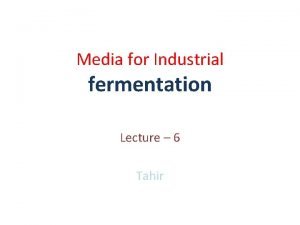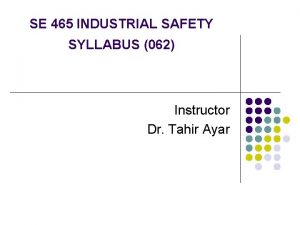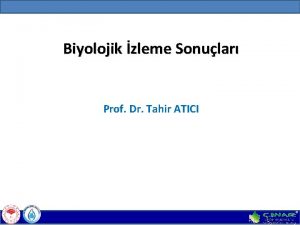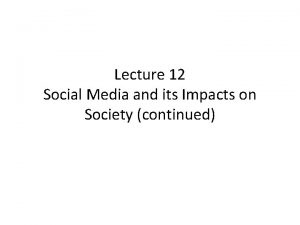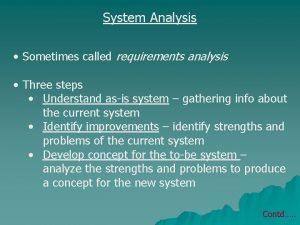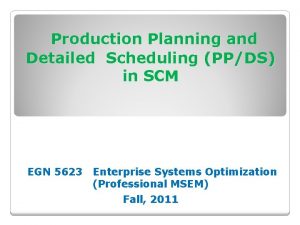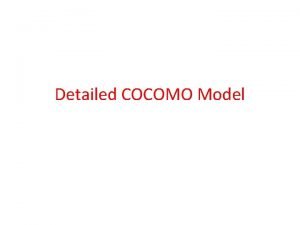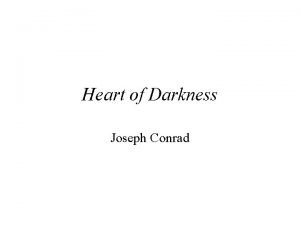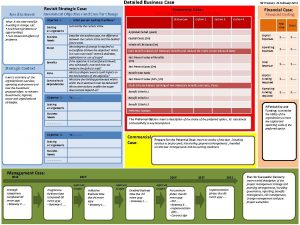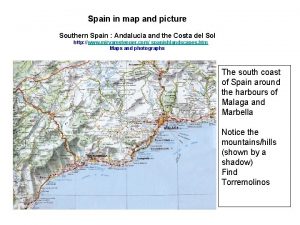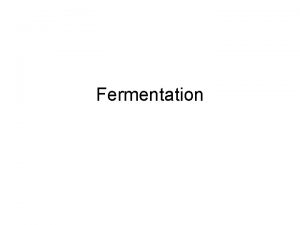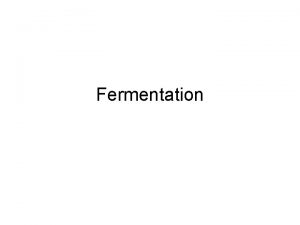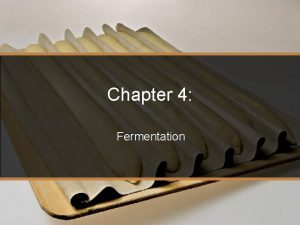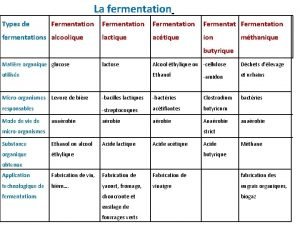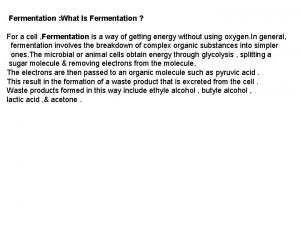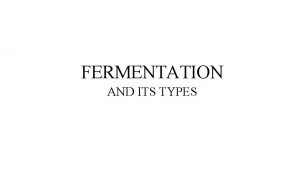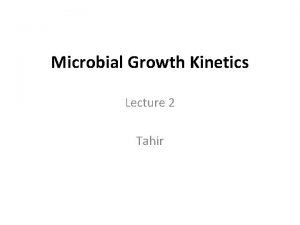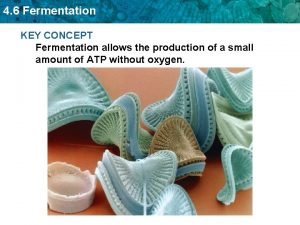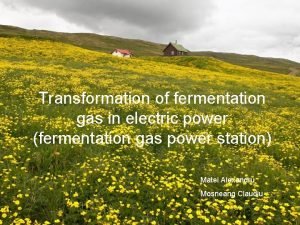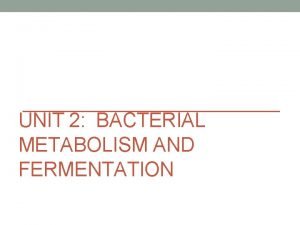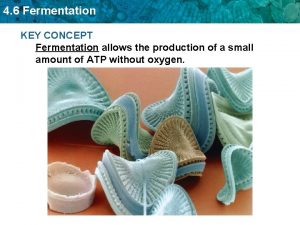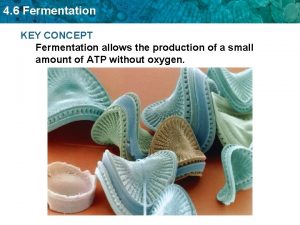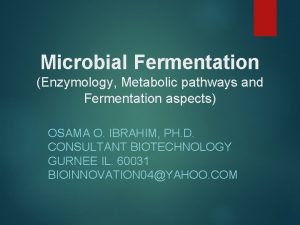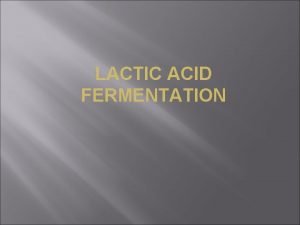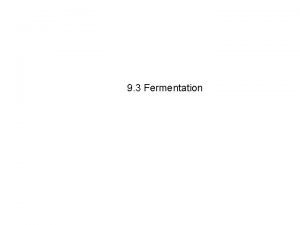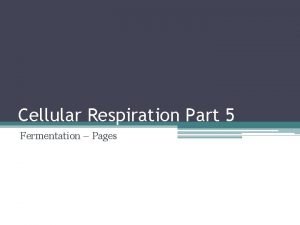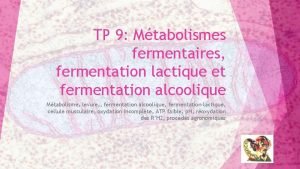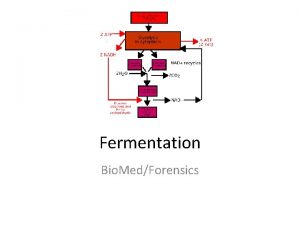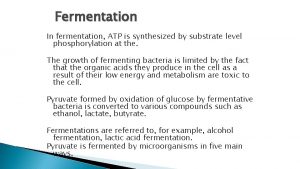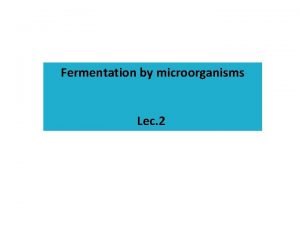Media for Industrial fermentation Lecture 6 Tahir Detailed
































- Slides: 32

Media for Industrial fermentation Lecture – 6 Tahir

• Detailed investigation is needed to establish the most suitable medium for an industrial fermentation process, but certain basic requirements must be met by any such medium. • All microorganism requires water, source of energy, C, N, Mineral, vitamins, oxygen (aerobic). • On a small scale its easy to maintain but on large scale very difficult to maintain the satisfactory growth.

On a large scale one must normally use sources of nutrients to create a medium which will meet as many as possible of the following criteria: • The use of can molasses, beet molasses, cereal grains, starch, glucose, sucrose & lactose as carbon source & NH 4 salts, nitrates, corn steep liquor, soya bean meal, slaughter house waste and fermentation residues as N source – meet the above criteria for production media b/c they are cheap material. • Use simpler procedures, select suitable sporulation and inoculation media. • Medium selected will affect the design of fermentar. • Eg. ICI develop special fermentar for the production of NH 3 & CH 3 OH. • Microbial oxidation of Hydrocarbons is a highly aerobic and exothermic process thus production fermentar should have a vey high O transfer capacity with excellent cooling facilities. • Air lift fermentar design by ICI solve the problem.

• The problem of developing a process from the laboratory to the pilot scale & subsequently to the industrial scale must also be considered. • Lab medium may not be ideal in a large fermenter with a low gas transfer pattern. • A medium with high viscosity will also need a higher power input for effective stirring. • p. H variation, foam formation, oxidation reduction potential & the morphological form of the organism, metabolic inhibitors – these are also very important. • Medium will also affects product recovery & effluent treatment.

• Historically – undefined complex natural materials used – although they are cheaper but unpredictable biomass/yield problems. • Product recovery difficult, residual components my interfere with the recovery and contribute to the BOD of the effluent. • Although defined media is more expensive but it give more predictable yield then undefined media. • Control of p. H and foam during growth in a fermenter were indentified as two important parameters. • Molasses would normally be used as the cheapest carbohydrate to grow yeast biomass in a large scale process. But this is not acceptable for Recombinant protein production b/c of difficulties and cost for purification. • Colins – used defined medium with glucose, sucrose, animal salts, trace elements, pure vitamins & NH 4 as N source & for p. H control, also used antifoaming agent.

Medium Formulation • Medium formulation is an essential stage in the design of successful laboratory experiments, pilot – scale development and manufacturing process. • The constituent of the medium must satisfy the elemental requirements for cell biomass & metabolite production and there must be an adequate supply of energy for biosynthesis. C + N+ O 2 +other req ------- biomass + product + CO 2 + H 2 O + Heat • This equation should be expressed in quantitative terms, which is important in the economical design of media if component wastage is to be minimal. • Thus, to calculate the minimal quantities of nutrients which will be needed to produce a specific amount of biomass, it should calculate substrate concentration necessary to produce required product yields.

• Coonye 1981 – some nutrient are frequently added in substantial excess of that required eg P, K, some trace eg. Zn, Cu. Conc of P is deliberately raised in many media to increase the buffering capacity. It depend on the medium design. • Some microorganism can't synthesize specific nutrients eg AA, vitamins or nucleotides. Once a specific growth factor has been identified it can be incorporated into a medium. • C has a dual role in Biosynthesis & energy generation. C requirement for biomass production under aerobic condition may be estimated the cellular yield Y which is defined as Quantity of cell dry matter produced/quantity of C substrate utilized.

• Oxygen – provided by aerating the culture, the design of medium will influence the oxygen demand of a culture in that the more reduced C sources will result in a higher O 2 demand. Water: required in • Heating , cooling, cleaning & rinsing • It required in large quantities, p. H, Dissolved salts and effluent contamination • Mineral requirement of water is very important in brewing & most critical in the mashing process. • Hard water containing Ca. SO 4 concentration are better for the “English Burton bitter beer” while water with high CO 3 contents are better for the darker beers i. e stouts. • Nowadays, water may be treated by deionization, salt added or p. H adjusted, depend upon the type of breweries. Reuse or efficient use of water is normally of high priority. • SCP produced 60, 000 tones by ICI, used huge amount of water on single use bases, (30 g biomass (dw) dm-3 would require 2700 x 106 dm 3 of water per annum. • Eg. Methylophilus methlotrophus could grown successfully with 86% continuous recycling of supernatant with addition to make up depleted nutrients. It result in reduce capital cost and operating cost by 50%.

Energy Sources • Energy comes either from oxidation of medium components or from light. • Most industrial microorganism are chemoorganotrophs, therefore the commonest source of energy will be the carbon (CHO), lipids & protein. • Some micro-organisms can also use hydrocarbons or methanol as carbon & energy sources.

Carbon Sources Factor influencing the choice of carbon source: • Rate at which the C source is metabolized can often influence the formation of biomass or production of primary or secondary metabolites. • Fast growth due to high concentrations of rapidly metabolized sugars is often associated with low productivity of secondary metabolites.

• Some use less readily metabolized sugar i. e lactose but many process need continuous or semi continuous supply of sugar. • Main product of fermentation process depend on the choice of C source. • Eg. Ethanol, or SCP - 60 -77% of the production cost depend on cost of C source. • it is the part of Company development program – to determine the alternative C source to determine the yield. • The purity of the C source may also affect the choice of substance. • The method of media preparation, particularly sterilization may affect the suitability of CHO for individual fermentation process. • Its often best to sterilize sugar separately b/c they may react with NH 4 ions & AA to from black N containing compounds which will inhibit the growth of many microorganism. • Starch when sterilize it become gelatinizes give rise to very viscous liquid. • The choice of substrate may also be influenced by Govt rules, eg. Beet sugar and molasses is encouraged. Scotch malt whisky may be made only from barley malt, water and yeast.

Carbohydrates • Its common practice to use CHO in microbial fermentation e. g starch from maiz grain • It may also obtained from, others cereals, potatoes & cassava. • Hydrolyzed cassava starch is used as a major C source for glutamic acid production. • Syrups produced by acid hydrolysis may also contain toxic products which may make them unsuitable for particular processes. • Sucrose is obtained from sugar cane & sugar beet. It is commonly used in fermentation media in a very impure form as beet or cane molasses which are the residues left after crystallization of sugar soln in sugar refining. • Molasses is used in the production of high volume/low value products such as ethanol , SCP, organic and AA and some microbial gums.

• Molasses or sucrose also may be used for production of higher value/low bulk products such as antibiotics, specially enzymes, vaccines & fine chemicals. • However, molasses based fermentation will often need a more expensive & complicated extraction / purification procedure to remove impurities & effluents which make the procedure costly. • Corn steep liquor is a by product after starch extraction from maize. Although primarily used as a N source, it does contain lactic acid, small amounts of reducing sugars & complex polysaccharides. (Table 4. 7) • In Soyabean & pharmadedia, along with N, it also contain small but significant amount of CHO.


Oils and Fats • • • Oils were first used as carriers for antifoams in antibiotics processes. Vegetables oils may also be used as C substrates, particularly for their content of the fatty acid, oleic, linoleci and linolenic acid b/c of cost are competitive with those of CHO. Bader 1984 – factors favouring the use of oils instead of CHO. A typical oil contains approximately 2. 4 times the energy of glucose on a per weight basis. Oils also have a volume advantage as it would take 1. 24 dm 3 of soya bean oil to add 10 KCal energy to a fermenter whereas it would take 5 dm 3 of glucose or sucrose assuming that they are being added 50%w/w solutions. Ideally in any fermenter, max working capacity should be used. Oil based fed-batch fermenter permit this procedure to operate more successfully. Oil also has antifoam properties which may make downstream processing simpler. Glycerol trioleat is known to be used in some fermentation where substrate purity is an important consideration. Methly oleate has been used as the sole C substrate in cephalosporin production

Nitrogen sources: • Most industrially used microorganism can utilize inorganic or organic sources of nitrogen. • Inorganic N may be supplied as NH 3 gas, NH 4 salts or nitrates. NH 3 has been used for p. H control & as the major N source in a defined medium for the commercial production of human serum albumin by yeast. • NH 4 salts i. e (NH 4)2 SO 4 will produce acid conditions & NH 4 NO 3 normally cause an alkaline drift. • When the NH 4 ion has been exhausted, there is an alkaline drift as the nitrate is used as n alternative N source. • In the presence of nitrate the assimilation of NH 3 is inhibited at p. H 2. 8 -3. 0. nitrate assimilation continue until the p. H has increased enough to allow the NH 3 assimilation mechanism to restart. • Organic N may be supplied as AA, protein or urea. Other proteinaceous N compounds serving as sources of AA include cornsteep liquor, soyas meal, peanut meal, cotton seed. • In storage these products may be affected by moisture, temp, & ageing.


Factors influencing the choice of N source • Control mechanism exist by which NO 3 reductase an enzyme involved in the conversion of NO 3 to NH 4 ion, is repressed in the presence of NH 3. • In Aspergilus nidulans NH 3 also regulates the production of alkaline & neutral proteases. • In Antibiotic production by many microorganism is influenced by the type and concentration of the N in the culture medium. • Antibiotic production may be inhibited by a rapidly utilized N source (NH 4, NO 3). • Antibiotic production only begins to increase in the culture broth after most of the N consumed. • E. g in the production of polyene antibiotic, soybean has been considered a good N source b/c of the balance of the nutrients, low P content & slow hydrolysis. This gradual breakdown prevent the accumulation of NH 4 ions & repressive AA. • Some complex N material cant be utilized by a micro-organism & create problems in downstream processing & effluent treatment. This can be an important factor in the final choice of substrate.

Minerals • All micro-organism requires certain mineral elements for growth & metabolism. • In many media, Mg, P, K, S, Ca & Cl are essential components, Co, Cu, Zn, Fe, Mn, Mb & Zn are also essential • P is used as a Buffer to minimize p. H changes when external p. H is not being used. • in specific processes the conc of certain minerals may be very critical. • Garner 1950 – Ca salts is used to ppt the excess inorganic PO 4 so indirectly improve the yield of streptomycin. • It also influence the production of bactricin, citric acid, ergot, monomycin, novobiocin, oxytetracycline, polyene, ristomycin, rifamycin, streptomycin, vacomycin & viomycin

• Liras 1990 – enzymes were repressed by PO 4, a PO 4 control sequence has also been isolated & characterized from the PO 4 regulated promoter that control biosynthesis of candicidin. • Wienberg 1970 – nine trace element proved to be critical, conc of Mn & Zn are the most critical in secondary metabolism. • Cl does not appear to play a nutritional rule in the metabolism of fungi but however required by some of the halophilic bacteria. Eg. Chlortetracycline & griseofulvin. • Other Cl containing metabolites are caldriomycin, nornidulin & mollisin.

Chelators • Many media can’t be prepared or autoclaved without the formation of a visible ppt of insoluble metal PO 4. • The problem of insoluble metal PO 4 may be eliminated by incorporating low conc of chelating agents i. e EDTA, citric acid, polyphosphate etc • These chelating agents form complexes with the metal ions in a medium. The metal ions then my be gradually utilized by the micro-organism. • Chelating agent does not cause inhibition of growth.

Growth Factors • Vitamins, specific AA, fatty acids or sterols. • Many of the natural C & N sources used in media formulation contain all or some of the required growth factors. • If only one vitamins is required it may be move economical to add a pure vitamin instead of large bulk of cheaper multiple vitamins source. E. g Ca pantothenate has been used in one medium formulation for vinegar production. • In glutamic acid, limited conc of biotin must be present in the medium, some requires thiamin.

Buffers • The control of p. H may be extremely important if optimal productivity is to be achieved. • Many media are buffered at about p. H 7. 0 by the incorporation of Ca. CO 3, if p. H decreases the CO 3 is decomposed. • PO 4 which are the part of many media also play an important role in buffering. High PO 4 conc are critical in the production of many secondary metabolites. • C & N sources will also a basis for p. H control as buffering capacity can be provided by the protein, peptides & AA such as in corn steep liquor. • The p. H may also be controlled externally by addition of NH 3 or Na. OH & H 2 SO 4.

The addition of precursors & metabolic regulators to media • Some components of a fermentation medium help to regulate the production of the product rather than support the growth of the micro-organism. Such additive include, precursors, inhibitors, Precursors: • Some chemicals when added to certain fermentation are directly incorporated into the desired product. • E. g Pinicillin yields • A range of diff side chain can be incorporated into the penicillin moleucle, eg corn steep liquor increased the yield of pinicillin form 20 units to 100 units. • Corn steep liquor contain phenylethlamine when incorporated, it yield benzyl penicillin. • Phenylacetic acid is widely used precursor in penicillin production.


Inhibitors • When certain inhibitors are added to fermentations more of specific product may be produced. • Glycerol production depends on modifying the ethanol fermentation by removing acetaldehyde. • Inhibitors have also been used to affect cell wall structure and increase the permeability for release of metabolites. • The best example is the use of penicillin & surfactants in glutamic acid production.

Inducers • The majority of enzymes which are industrial interest are inducible. • Induced enzymes are synthesized only in response to the presence in the environment of an inducer. • Inducers are often substrate such as starch or dextrins for amylase, maltose for pullulanase & pectin for pectinase. • Most inducers which are included in microbial enzyme media are substrate or substrate analogues but intermediates and products may sometime be used as inducers. • E. g maltodextrins will inudce amylase & fatty acids induce lipase. (use depend upon the cost) • It is not possible to produce a no of heterologous protein (HLP) in yeasts, fungi & bacteria. But HLP may show some degree of toxicity to the host, it may restrict the growth and biomass. • One commercial system based on the alc A promoters in aspergillus nidul-ans to express human interferon alpha 2. this can by induced by volatile chemicals i. e ethylmethyl ketone added when biomass increase to an adequate level.


Oxygen requirement • Very important in controlling growth rate & metabolic production. Medium may influence: Fast metabolism: culture may become oxygen limited b/c sufficient oxygen can’t be made available in the fermeter if certain substrate such as rapidly metabolized sugars which lead to a high oxygen demand are available in high conc. Rheology: the individual components of the medium can influence the viscosity of the final medium & its subsequent behavior with respect to aeration & agitation. Antifoam: Many of the antifoams in use will act as surface active agents & reduce the oxygen trasnfer rate.

Fast Metabolism • Nutritional factors can alter the O demand of the culture. • Penicillium chrysogenum will utilize glucose more rapidly than lactose or sucrose, & it therefore has a higher specific O uptake rate when glucose is the main C source. • Therefore, when possibility of O limitation due to fast metabolism, it may be overcome by reducing the initial conc of key substrates in the medium and adding additional quantities of these substrates as a continuous or semi continuous feed during the fermentation. • It can also be overcome by changing the composition of the medium, incorporating higher CHO (lactose, starch) & protein which are not very rapidly metabolized & do not support such a large specific O uptake

Rheology: • There can be considerable variation in the viscosity of compounds that may be included in fermentation media, eg. Polymer in solution ie polysaccharides • As polysaccharides degraded, the effect on rhelogical properties will change. Antifoam: • In most microbiological process, foaming is a problem. It may be due to a component in the medium or some factor produced by the microorganism. E. g most common due to protein i. e corn steep liquor, pharmamedia, peanut, soybean, yeast extract or meat extract • These proteins may denature at the air broth interface & form a skin which does not rupture readily. • The foaming can cause remove of cells from the medium which will lead to autolysis & the further release of microbial cell proteins will probably increase the stability of the foam. • If uncontrolled, then numerous changes may occur & physical & biological problems may be created. • These include reduction in the working volume of the fermenter due to O exhausted gas bubbles circulating in the system, lower mass & heat transfer rates, invalid process data due to interference at sensing electrode & incorrect monitoring & control. • Biological problem inlcudedeposition of cells in upper parts of the feremnter, problems of sterile operation with the air filter exist of the fermenter become wet, so danger of microbial infections, so loss of product.

 Uses of buffer solution
Uses of buffer solution Tahir bayındır defterdar
Tahir bayındır defterdar Tahir büyükelvacı
Tahir büyükelvacı Marie tahir
Marie tahir Kaymakam mehmet tahir imam hatip ortaokulu
Kaymakam mehmet tahir imam hatip ortaokulu Vigenere cipher
Vigenere cipher Tahir ayar
Tahir ayar Sonular
Sonular 01:640:244 lecture notes - lecture 15: plat, idah, farad
01:640:244 lecture notes - lecture 15: plat, idah, farad Lecture about social media
Lecture about social media Case description
Case description Bpa bpi bpr
Bpa bpi bpr Objectives of skimming and scanning
Objectives of skimming and scanning Production planning and detailed scheduling
Production planning and detailed scheduling Detailed lesson plan in hairdressing
Detailed lesson plan in hairdressing The main objectives of a detailed system proposal are to
The main objectives of a detailed system proposal are to Elizabeth bishop quotes leaving cert
Elizabeth bishop quotes leaving cert Detailed routing
Detailed routing Cocomo model example
Cocomo model example Joints drawing
Joints drawing Detailed lesson plan about problem solving
Detailed lesson plan about problem solving Detailed design in software engineering
Detailed design in software engineering Assembly drawing example
Assembly drawing example Whited sepulchre heart of darkness
Whited sepulchre heart of darkness Function oriented design in software engineering
Function oriented design in software engineering Detailed business case
Detailed business case Intermediate cocomo example
Intermediate cocomo example Write a detailed note on unicast routing protocols
Write a detailed note on unicast routing protocols What is detail drawing
What is detail drawing Standard scale drawing
Standard scale drawing Southern spain map
Southern spain map Solid in engineering drawing
Solid in engineering drawing Riddle
Riddle
